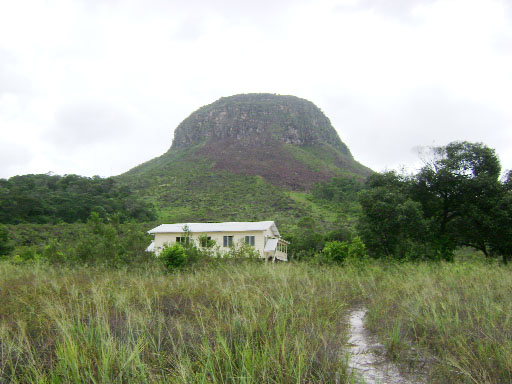The woman said she wanted to be “free again”. In a village sited in one of the most scenic parts of Guyana and with wide-open spaces, it seemed an incongruous remark to make, but there is always a story isn’t there? And this is a tale of apparent neglect.
Arau, June 2008. A tiny Amerindian village, located close to the Venezuelan border, of about 190 poverty-stricken souls struggling to get out of that abyss and fighting for what could very well be their lives.
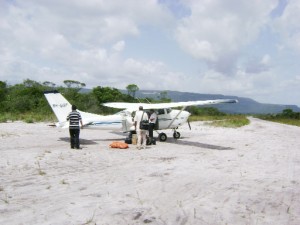
Piqued by stories of the village being severely affected by mining operations, I travelled to Arau late last month. Covering a story that encompasses mining, the environment and its effects on residents is never an easy task, mainly because of location and accessibility given that virtually all mining operations are in the interior.
Getting to Arau is a tale in itself. Going, I was worth, along with 25 pounds of baggage, approximately $29,900. Returning I was “priority” and was charged $32,000. And for the period in-between, I listened to the people, visited the mines, climbed mountains — clambering up and down the steep sides, crossed rivers on tree trunks, viewed some of the most beautiful scenery in Guyana and cemented my hatred for turtles.
Arau is only easily accessible by plane unless you want to spend days travelling over several rivers. There are no scheduled flights by any local airline but miners charter planes on a regular basis, every Wednesday and Saturday.
I was unprepared for the wait at the Ogle aerodrome. When I arrived there for what was supposed to be an 8 am departure, astonishment took over as I was booked, on learning that I had to pay according to my weight. Slim person that I am, I smirked as the clerk checked my weight twice.
The chief of the village, Devroy Thomas met me early at Ogle, but the plane did not take off until after midday. The reason for the delay? The weather and I got to know this factor only too well over the next few days.
Arau, as I was told, is located on a mountain and to get down I would have to “run downhill for half an hour”. It was a strange remark, but I later learnt that it was almost true.
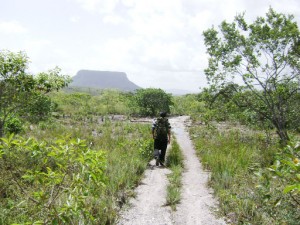
Flat-topped mountain
The flat-topped mountain stood out; not because it was flat, but because in the midst of a long range, it stood alone. The upper portion was sheer rock and it looked forbidding and picturesque at the same time; awe-inspiring. Locals call it Pagrampa but on the map it is Pegall Mountain. At the base of this rock, sat Arau, looking tiny and scenic from the air. On the ground it was the same, but different, and a different story emerged.
Arau, simply put, should not be where it is. But that is just the opinion of the map and those who want to exploit the surrounding areas for gold. A mixed Akawaio and Arecuna (Amerindian tribes) village with a population of just about 190 people, it holds title to a piece of land as a reservation.
However, the village is
outside the legally held land and so too, according to the villagers, are the traditional hunting and farming areas. They are fighting to have this changed. While they gained title to the piece of land they now control in 1991, and lived without any major problems for years, change was inevitable. Gold came, or rather the miners descended on the surrounding area. From far away they came, lured by the gold, hidden in the streams and underground. With their arrival, tensions erupted between them and the locals and problems emerged.
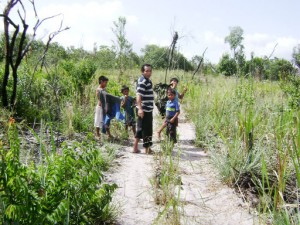
Guyana’s interior as viewed from the air is a big green carpet, albeit one made out of trees. Different hues of greenery, the crisscrossing of rivers, and mining camps scattered here and there, some singly others seemingly in a line lend some variation to the mass, but becomes somewhat monotonous after a while.
At first you do not recognize it, but then there is an almost imperceptible change. The seemingly flat portion of the forest deceives, until you look again. Then ridges are outlined, the earth raises gently then more sharply as the plane zooms lower. Heavy dark forests give way to lighter woodland and savannah that sit upon flat-topped mountains, where dark-coloured waters crash and foam down the many waterfalls and rapids.
Sheer bare rock cliffs and others with trees clinging to them, mark the edges of some mountains. Dark coloured rivers breaking into foaming spray as they tumble down the perilous cliffs are awe-inspiring. Inexplicably, perhaps because I have no image with which to compare the sight, I thought of the American-southwest, but with trees, a tropical version, so to speak, similar but so very different. This is the Pakaraimas of western Guyana, raw beauty and a whole different side of Guyana, unheard of and unknown to many.
Mesa-like Pegall stands out, aloof like the legends it has inspired. Before I left, I would climb halfway up that mountain, where the sheer rock began just to “see if I could”. I did, with many heart-stopping moments. I wonder if I would ever someday get to the top. Me? A mountain climber? Unlikely, but I climbed that mountain or part of it anyway!
Birdman
‘Birdman’ smoked. He lived in a tiny plastic hut at the side of the short, sandy airstrip, which he helped to maintain and he trapped finches (Towa-towa) and has a number of birds. He was friendly but also liked his privacy and declined to state his real name. The silence, after the plane left was disconcerting. One whiff of the pungent air close to Birdman’s camp revealed that he had just recently “burned the herb”. He expressed joy that he received some vegetables on the flight.
There is a habit among Arau residents, that when they speak of distance, they speak in terms of hours. Assuming that the village was close-by I asked the Chief how far. His answer, “about one and a half hours from here”, was not comforting although I had not yet absorbed the implications of that.
“I meant how far away the village is, in terms of miles?”
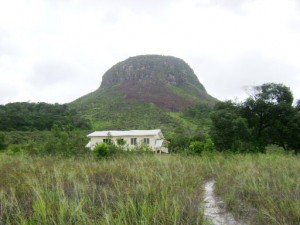
“Only about 3.6 miles. You ready or you going straight to the mines?”
Realization almost floored me. Where were the people? Where was the vehicle? The Chief slung his backpack across his back and started walking and it clicked. I had to walk the 3.6 miles with my bag to the village. Hurriedly dousing the exposed portions of my body with insect repellent, I grabbed my bag and followed wondering whether I was going to make it.
If you have never fetched more than a bucket of water upstairs, or walked further than just out of the ‘scheme’ and then suddenly have to fetch luggage and walk up and down steep hills for miles, you would have a general idea of how I felt. The initiation was brutal. The humid atmosphere ensured I was sweating heavily as we descended the first steep hill. After the first few minutes, with every step, the weight seemed to increase and as I walked along the rocky path, periodically switching by bag from my right to my left shoulder, I wondered what on earth I was doing there. I had snapped a few photos of strange plants earlier, but as fatigue overtook me, I lagged behind and finally just concentrated on putting one foot in front of the next and got the idea to carry my bag like a backpack. As we came to various streams I was forced to take my boots off and wade.
Pausing at every hilltop to marvel at the breathtaking scenery, in particular the waterfalls tumbling down the mountainsides and the different sides of Pegall, but in reality, just to catch my breath, I wondered what would happen if I decided to just sit down and refuse to move. After I had struggled for about three-quarters of the way, help finally arrived. Several young boys, who looked no more than ten years old, ran up. Relieved, I couldn’t understand why they were laughing at me as I drank my bottled water. Maybe it was because I looked so hot and sweaty, with the heat and humidity and all. Anyway, I no longer had to fetch my bag, which I had planned to hurl away earlier in any case, and was finally free to shoot photos, many of which were to later be unceremoniously discarded, and to really marvel at the spectacular scenery.
Arau loomed as we crossed the last hill. The distance was deceiving as we were on top of a ‘semi-mountain’.
The delivery room
My hotel, so to speak, for the next few days, was the health centre, which was at the base of Pegall. There were three rooms with beds, one marked ‘Male’, the other ‘Female’ and the third, Delivery’. I was placed in ‘Delivery’ and received a negative response to my query about mosquitoes. Notwithstanding that, I insisted on a mosquito net. ‘Delivery’ was the best room anyway.
Most of the villagers’ homes were of uneven pieces of board and weathered zinc sheets, and sheds were made out of old tarpaulins, though there were some traditional thatched houses. The Seventh Day Adventist Church was the only one in Arau and many of the villagers worshipped there.
After settling in, I was summoned to the Chief’s houses, where I was offered ‘tuma-pot’, a traditional dish made out of casareep, lots of pepper and meat or fish. It could be kept for a number of days with meat added as it was consumed. When the pepper disappears and the dish is no longer hot, it is time for a new one. I politely declined but took a few sips of ‘casak’, which is the local name for casiri, a traditional drink, made out of cassava. I ate chicken, cooked in a stew. Chicken cost over $1,000 per pound here and was imported from Venezuela by miners.
I took my first walk to the Arau River that afternoon. The water was an orange-yellow colour and the village councillor, who took me there, lamented the state of it. He said the situation had been the same for some years and although numerous complaints were made, the condition had never improved, save for a few days sometimes when mining officers visited. It was a cry I would hear often over the next few days.
And so my visit began, with aching legs, which was nothing compared to what was to follow. Glimpses of a hard life, which I doubted I would have been able to survive. More was to come; cheap gasoline, expensive chicken, gold, Brazilian prostitutes, climbing Pegall, unpredictable weather, scary local folklore, the Wenamu River, village life, strange animals, running down the mountain, and the hated turtles. I hope it was made into turtle soup.

